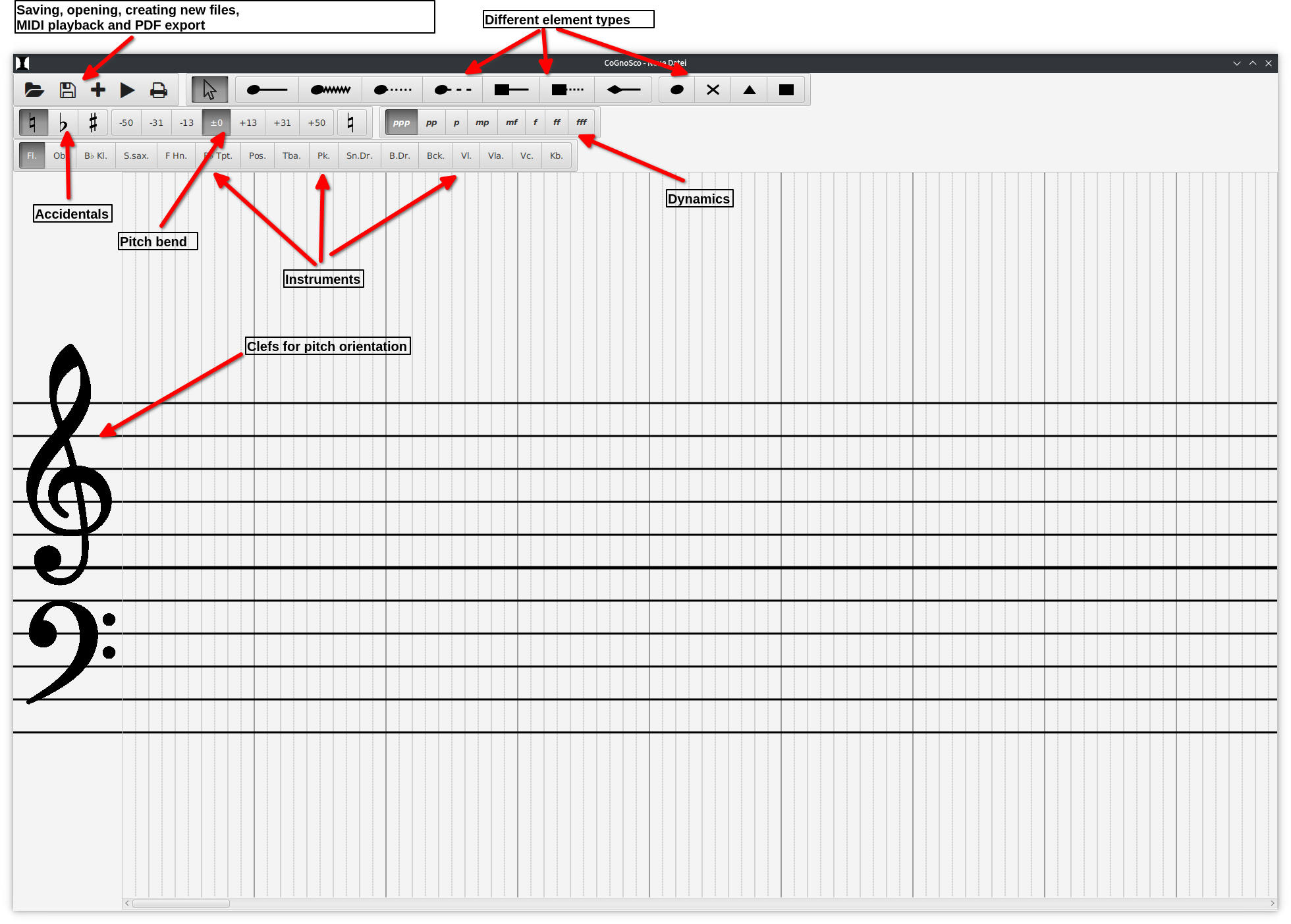CoGnoSco is a user interface to Convert Graphic notations to ordinary Scores.
When you start CoGnoSco it will show a new graphic score.
 Creating and editing scores should be almost self-explanatory.
Creating and editing scores should be almost self-explanatory.
These shortcuts trigger global actions independent of the currently selected element.
| Shortcut | Action |
|---|---|
T |
Focus element-type bar |
D |
Focus dynamics bar |
B |
Focus pitch bend bar |
+ |
Select next-louder dynamic |
- |
Select next-quieter dynamic |
N |
Select natural-sign |
F |
Select flat-sign |
S |
Select sharp-sign |
Ctrl+O |
Open file |
Ctrl+S |
Save file |
Ctrl+N |
Create new file |
SPACE |
Play/Pause/Resume |
Ctrl+P |
Create PDF Score |
These shortcuts trigger actions local to the currently selected element.
| Shortcut | Action |
|---|---|
Esc |
Abort element creation and go into select mode |
Delete |
Delete element |
Ctrl+⬇ |
Move selected note head down |
Ctrl+⬆ |
Move selected note head up |
Ctrl+⬅️ |
Move selected element left |
Ctrl+➡️️ |
Move selected element right |
To avoid using the mouse, you can navigate the parameter-bars (e.g. for accidentals, dynamics, etc.) with the arrow keys,
Also, you can select elements of the parameter-bars
by pressing their corresponding (zero-based) index in the focused parameter-bar.
For example, to select the instrument Oboe,
type I to focus the instrument parameter-bar
and then 1 to select the second instrument.
The simple elements are the ones that don't have a line attached to them. To create a simple element, simply select the intended element-type, accidental, dynamic and instrument in the parameter-bars and then click into the stave-area, to select the position and pitch of the element.
Select one of the element-types that do have a line attached to the shapes, choose the additional parameters, and click into the stave-area, to select the pitch and the start of the crescendo. Next, choose the climax by clicking into the stave-area a second time, while having the climax-dynamic selected. Lastly, choose the end of the decrescendo by clicking into stave-area a third time, while having the end-dynamic selected.
To create a trill, select the trill element-type (it's the second element of the element-type parameter-bar),
for example by typing T and then 2.
Then choose the position and pitch of the trill start.
When you have chosen a pitch by left-clicking, a second tinier note appears,
which represents the secondary pitch of the trill.
By pressing Enter you confirm the secondary pitch.
The rest is similar to creating crescendo-decrescendo elements
Graphic scores are stored in JSON format. To create, open, and save files, use the corresponding action buttons or the keyboard shortcuts mentioned in Global shortcuts.
Graphic scores created with CoGnoSco can be converted to ordinary scores in the PDF format.
(In fact, this is the whole point of the project.)
CoGnoSco uses LilyPond to typeset scores,
so the lilypond-command should be on your path if you want to export scores.
CoGnoSco supports rudimentary MIDI playback.
The ▶-Button is used to play, pause and resume playback.
If you just want to typeset scores stored as JSON files, you don't have to do this via the user-interface. Instead, you can use the small Command line interface provided by CoGnoSco. The supported commands are:
| Command | Action |
|---|---|
launch <file> |
Launches CoGnoSco opening the specified file |
typeset <file> |
Creates a ordinary score from the graphic score contained in the specified file |
play <file> |
Plays the specified graphic score using MIDI |
help |
Prints a help page |
Being built on top of the JavaFX Framework, CoGnoSco should run on pretty much any OS. Just clone the project locally
git clone https://github.com/NKb03/CoGnoSco.git
and then build and run it using Gradle
./gradlew run.
To export graphic scores as ordinary PDF scores you need LilyPond on your path.
Nikolaus Knop (niko.knop003@gmail.com)
This project is licensed under the GNU General Public License - see the LICENSE file for details.